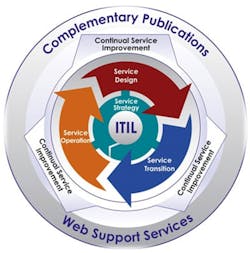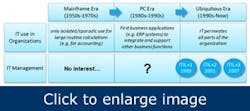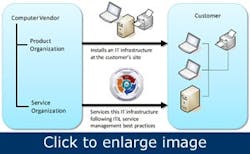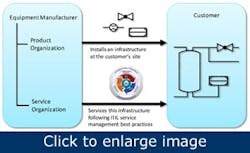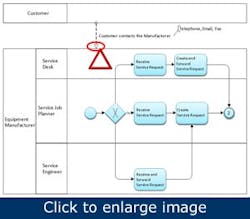In brief:
- ITIL is a set of best practices that suggest how IT infrastructures can be managed by the users of that technology.
- ITIL treats IT infrastructure as an enabler to reach the targeted business goals; it focuses on market-proven good practices; it avoid having to go through repeated lesson-learning and wheel-reinventing.
- It organizes best practices around the five phases of service lifecycle, from planning and implementing IT-based services to a continuous service improvement.
The Information Technology Infrastructure Library (ITIL) is a de facto standard for IT services. ITIL was developed by the Office of Government Commerce (OGC), a British governmental agency whose responsibility is to optimize the procurement and acquisition processes of the British public sector. It’s based on a collection of best practices that originate from the different stages of a service lifecycle framework. They cover guidance for building a service strategy as well as developing, implementing, operating and continuously improving services. The framework was developed for the IT and telecommunication sector and, therefore, at a first glance, doesn’t seem to be of immediate use to an industrial maintenance manager. However, because of a strong conceptual overlap, the principles of ITIL also can be applied to the industrial field service sector. You should know the basic principles of ITIL and its applicability to industrial service organizations.
What is ITIL?
The core purpose of the Information Technology Infrastructure Library is to standardize the provision of IT-related services to ensure efficiency and a high level of service quality. The ITIL approach covers both the processes and the resources (human and material) that execute them. ITIL’s key focus is on the service provider, who can be internal or external to the customer’s organization.
As illustrated in Figure 1, commercial use of computers started in the 1950s, when some extensive routine calculations (e.g. for accounting) were simply automated by huge calculators – the mainframes –hidden somewhere in the basement. Upper management found little interest in being involved in the planning and management of such resources.
Figure 1: History of IT and ITIL in organizations (based on Simonovich)
Towards the end of the last century business saw a strong emergence of information technology in practically every department and process of the organization. Email became a key channel for human interaction; accountancy and HR implemented their processes in SAP, marketing and sales discovered the Internet, production achieved productivity gains through automation systems and so on.
In 1989 it had occurred to Britain’s OGC that through the emergence of information technology, organizations also became more dependent on these technologies. However, there was still a strong confusion how that IT infrastructure should be managed. Experience showed that without proper management of IT, several problems occur. For example, one element of bad IT management is cost inefficiency and suboptimal quality of IT-dependent business processes. Another is limited organizational responsiveness to increasingly saturated and competitive market environments. Organizations can be only as agile as their underlying IT infrastructure upon which it increasingly depends.
[pullquote]In response to these developments, the OGC published ITIL, a set of best practices that suggest how IT infrastructures can be managed. In 2001, the OGC published ITIL version 2 and reduced the number of volumes from 44 to 9. Version 3, the current version, was published in 2007. It consists of 6 volumes and moves from a process-based view to one based on a continuous service lifecycle. Today, ITIL is quite popular: The UK's National Health Service, IBM, HP, Microsoft, Shell Oil, Proctor & Gamble and British Airways, are examples of extensive ITIL practitioners.
ITIL version 3 has four key strengths. It treats the IT infrastructure not as overhead but as an enabler to reach the targeted business goals. ITIL supports strategic decisions by putting its focus on the organization’s goals. Traditional approaches treat IT as a separate concern, so any local solutions won’t necessarily benefit the organization as a whole. This leads to cost inefficiency and low quality.
Also, ITIL focuses on market-proven good practices. It helps organizations avoid having to go through its own lesson-learning and wheel-reinventing and it promotes operational excellence. Caterpillar, for example, increased its success rate in resolving customer problems within a fixed time from 30% to 90%. And Proctor & Gamble saved $125 million after implementing service management processes ITIL outlined.
ITIL’s third strength is its focus on standardization. A key ITIL concept is a common language where a confusion of meanings of terms had prevailed. This doesn’t only increase internal and external communication efficiency, it enables common thinking. Standardization also enables a better use of synergy effects and company resources.
Finally, ITIL not only helps improve service efficiency and quality, it makes this performance measurable through key performance indicators (KPIs). Service organizations would have little advantage in doing a good job it the “good” can’t be proven. Making service performance measurable also is a prerequisite for identifying performance deviations and appropriate corrective actions.
The ITIL version 3 service lifecycle
Version 3 organizes its best practices around a service lifecycle, from planning and implementing IT-based services to a continuous service improvement. As shown in Figure 2, ITIL v3 divides this lifecycle into the five phases: service strategy, service design, service transition, service operation and continuous service improvement.
Figure 2. The phases of the ITIL version 3 Service Lifecycle as depicted in ITIL v3 Service Strategy book.
The lifecycle starts with defining a service strategy. ITIL provides service management best practices as strategic tools for supporting the achievement of business requirements. A strong alignment of business and IT strategy results in a better correspondence of operational cost and risk with the firm’s expectations. The strategy intends to answer the questions: How do we build value for our customers, how do we define service quality and how can we justify strategic investments. Because third parties cover many IT services, the strategy also could cover questions about their service portfolio and competitive differentiators.
After formulating a service strategy, the next phase, service design, provides best practices for transforming the firm’s strategy into a detailed service catalog of services that are to be provided later in the service operation phase. This includes defining new or changed services and service management processes, outlining the required resources and capabilities for providing these services, and the development of a measurement system for assessing service performance during its execution.
The service transition phase provides best practices for transferring the newly designed or changed services into operation. The best practices suggest implementing and using a configuration management database (CMDB) which holds a detailed inventory of the IT infrastructure as well as changes to this infrastructure. Knowing what’s in place is essential to providing good service for it.
New or changed services go operational through the service transition, that is, they enter the service operation phase of the lifecycle. This phase offers best practices for providing services at the negotiated level. A key focus lies on dealing with abnormal events, reacting to incidents and problems. Other processes cover (minor) change requests and IT access rights management. The suggested organizational units include a service desk, operations management and application management.
Finally, the continuous service improvement phase is responsible for controlling the performance of management activities in each phase and taking corrective actions in case of deviations. The developed measurement system is used for this purpose. For example, if service availability during operation doesn’t meet expectations, the service manager should go back into the capacity management or availability management of the service design phase to adjust the resource plan or redefine target availability levels. This illustrates how it’s possible to go back to the management tasks of each lifecycle phase to take corrective actions and achieve a continuous service improvement.
Service organization case study
The high-level description above suggests a high level of similarity to industrial services. Consider an example that illustrates ITIL use for industrial service providers.
A typical use for ITIL in the IT sector is a computer vendor that leases servers, laptops, printers and other infrastructure and installs it at the customer’s site (Figure 3). Usually the vendor offers additional maintenance services as part of the leasing contract (so-called maintenance leasing) to ensure the infrastructure stays operational. The vendor typically makes use of ITIL service management best practices to find ways these services can be provided efficiently and effectively. Such best practices include establishing a single point of contact (SPOC) to the vendor, as well as the use of a ticketing system that make customer contacts traceable.
Figure 3. A schematic showing typical use of ITIL in the IT sector.
Is such a scenario applicable to an industrial equipment manufacturer? Like the IT vendor, the industrial manufacturer installs infrastructure products at a customer site (industrial plant). Typically, the manufacturer also offers various services for maintaining the plants to optimize time, cost and quality of those services and to ensure customer satisfaction. Here ITIL best practices can help achieving these goals (Figure 4).
Figure 4. The ITIL concept can be transferred to the industrial service sector.
A practical example is when a field service process should be analyzed with the help of ITIL for possible improvements. Figure 5 shows the first step of the process before the application of ITIL. It typically begins with the customer contacting the manufacturer to indicate a fault or express a wish. The customer might have three possible ways to contact a manufacturer (highlighted by the red triangle). That is, the service desk, the service job planner and a service engineer whose contact data (number, email address, etc) from previous contacts.
Figure 5. Multiple points of contact between a customer with a complaint or query and a manufacturer is what makes accurate tracking too difficult
ITIL’s best practice shows that three possibilities to submit a service request are considered problematic. In fact, ITIL suggests the best practice of having only one dedicated touch point – a so-called single point of contact (SPOC) – to receive customer service requests. Customers shouldn’t have direct phone numbers to service engineers, but always should contact this service desk. There are several advantages. For the customer, the SPOC ensures that service requests are tracked, managed and closed properly and that the customer always is notified about progress in a standardized manner. For the service provider, a centralized assignment process means that requests get routed to the appropriate level of expertise. This way, expensive specialists are available for difficult tasks such as root cause analysis instead of being tied up in trivial activities. Additionally, the provider can bill the business organization for executed activities and have a complete picture of the problems on site.
It’s good practice to set a target time (e.g. 6 minutes) within which the service desk should handle the complete fault indication process. The target time certainly depends on cost and complexity of the individual process. Such target times often are clearly defined in the SLAs of companies implementing ITIL, and they also can be used as KPI of a measurement system to control the service performance.
The service desk can try to solve incoming customer calls directly, but use no more than the target time. If the case can’t be solved within this time, it’s more cost efficient to send it to an appropriate person. Wasting even more time on it soon makes the cost/benefit ratio start to become unfavorable.
In this manner it’s now possible to use ITIL best practices to analyze the remaining field service process steps (such as personnel planning, on site repair, reporting and billing, etc) for improvement potentials. The ITIL framework doesn’t have to be implemented as a whole. You can use the books as a reference, selecting only those best practices that are relevant to a given problem and compare them to how the organization works today.
For example, the discussion above used best practices primarily from the “ITIL Service Operation” book. On the other hand, it didn’t mention, for example, strategic issues that are covered in the “ITIL Service Strategy” book.”
ITIL for industrial services
The example above suggests that ITIL is a valuable support for industrial service units. However, be aware of the differences between IT service and industrial service to avoid problems, especially in a partial ITIL implementation. A couple of minor differences can be fixed easily or ignored during an implementation. For example, some aspects of ITIL, such as application management, which covers software development, aren’t a key concern of industrial service providers. The main difference, however, lies in the definition of the term “service.”
ITIL defines a service as a “means of delivering value to the customers by facilitating outcomes customers want to achieve, without ownership of specific costs and risks.” There are two interesting aspects to this definition.
First, the service provided is the working support infrastructure (in this case IT) and not the repairs and troubleshooting. The outcome the customer wants to achieve is defined by business goals. IT as a secondary function in most businesses acts as an enabler. In industrial service terms, this would be equal to providing the manufacturing infrastructure as part of a service contract. However, typically, the customer owns the infrastructure and the service provider might not be the sole party responsible for its maintenance, let alone operations-related activities such as job scheduling.
Secondly, many industrial service providers don’t own the cost and risks at the customer plant. This means that they’re not directly responsible for meeting a specific OEE and are paid on the basis of troubleshooting effort. Naturally, there are exceptions in the case of outsourcing contracts or special warranties. Generally, however, a manufacturer’s service unit will be called only for troubleshooting. This leaves responsibility for long-term problem management in the customer hands, i.e. the service unit can’t take a holistic approach to improving the OEE, only make repairs and operation suggestions.
So, can/should ITIL be used in an industrial context? While there are some differences what constitutes a service, these deviations don’t prohibit the use of ITIL in an industrial context. However, keep the differences in mind when adapting the standard. Also, ITIL isn’t trivial to implement, even without adaptation. Many struggle with trying to understand ITIL and some can’t make it work at all. ITIL initiatives cost money; and Robert Barnes, global vice president of JPMorgan Chase, warns that “ITIL can be like throwing money out the window unless you have a clear understanding of your goals.” Various additional critical success factors have been identified in a case study that analyzed four ITIL implementation initiatives. According to a survey, one of the greatest barriers is human resistance to organizational changes ITIL might introduce. For example, increasing transparency through the introduction of measurement systems might cause resistance by service engineers as their performance will now be assessed and compared.
ITIL (IT Infrastructure Library) is a service management framework of best practices which describes the organization of resources and processes for designing and providing services to customers. The framework has its origin in the sector of IT service providers, because at the time when ITIL was developed organizations became increasingly dependent on their underlying IT infrastructures that special service management concepts where needed. Even though the definition of service in ITIL differs from that of a typical industrial service organization, we believe that the ITIL concepts are not limited to IT organizations. We have used an industrial field service process example to demonstrate how applying various ITIL best practices can help improving service efficiency and quality and making the service performance more measurable and controllable through performance indicators and measurement systems. Therefore we see good potential in ITIL also for industrial service organizations. Whether subsets of the ITIL standard or an adjusted variation will prevail in this sector remains to be seen.
Marcel Dix (Dipl.-Inform. FH) is a scientist at the ABB Corporate Research Center in Ladenburg, Germany. Contact him at [email protected] and +49 6203 71 6247.
Ralf Gitzel (Dr. rer. pol.) is scientist at the ABB Corporate Research Center in Ladenburg, Germany. Contact him at [email protected] and +49 6203 71 6108.
Chris M. Stich (Dipl. Ing.) is group leader at the ABB Corporate Research Center in Ladenburg, Germany. Contact him at [email protected] and +49 6203 71 6211.
